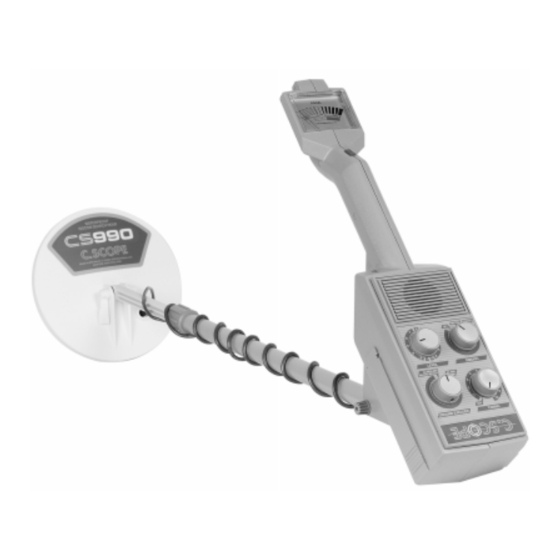
Subscribe to Our Youtube Channel
Summary of Contents for Velleman C.Scope CS990
- Page 1 CS990 Professional metal detector Operating manual Gebruikers handleiding Manuel de l’Utilisation...
- Page 2 CS-990 OPERATING INSTRUCTIONS INTRODUCTION These metal detectors are recognised as the finest detectors available. They are designed with lasting quality, high technology input, and above all, value for money in mind. The only way to realise this value and quality is to carefully study and understand this instruction manual.
- Page 3 Inland Mineralised Sites : The G 1 mode is the mode in which "Ground Exclusion" is achieved on the majority of inland sites. Beach and Non-Mineralised Inland Sites : The G 2 mode enables the detector user to ground exclude on wet salt sand beaches by using the variable ground exclude control knob identified as "LEVEL", positioned directly above the ground exclude control knob G 1 &...
- Page 4 Diagram 1 ON/OFF Tune Control SIMDISC Control GROUND EXCLUDE Control LEVEL Control AUTO-TUNE Button METER BATTERY CHECK Button BATTERY COMPARTMENT UPPER STEM MIDDLE STEM LOWER STEM SEARCH HEAD CS-990...
- Page 5 ASSEMBLY How to assemble your CS-990. Your CS-990 comes to you dismantled for ease of packing. To assemble it, follow these few easy steps : Locate the stems in the special compartment in the packaging. Loosen and remove the two screws and nuts from the base of the control box. Insert upper stem 1 into the aperture at the base of the case and replace the two screws and nuts and tighten.
-
Page 6: Controls And What They Do
Place the batteries and leads into the special recess, replace the battery cover and slide it firmly into place until you hear it click into position. Repeat this operation on the other side of the control box where the second battery compartment is located. - Page 7 C. GROUND EXCLUDE CONTROL This control enables the user to select a mode of operation best suited to the site to be worked on, for instance: G 1 is the mode to be used on mineralised inland sites and can be used in conjunction with any of the Simdisc modes described above depending on the nature of finds the user wishes to locate or reject.
- Page 8 G. BATTERY CHECK Battery check Button G is provided as a guide to the battery’s condition. To check the battery condition, switch on the detector by turning the On/Off switch in a clockwise direction whilst simultaneously pressing the auto-tune button, once the detector is tuned, release the Auto-Tune button and then press button G situated under the meter.
-
Page 9: Operating Procedure
OPERATING PROCEDURE The fundamental principle of detector operation is that the detector must be tuned to the correct level. This is the level when the signals are balanced, and this is indicated by the detector being neither silent nor sounding off. In fact, the correct tuning level is the threshold setting when the sound is just beginning to break through. - Page 10 Small pieces of silver paper are indicated by an increase in volume, however the frequency may not alter and the meter needle will remain in the centre or move just slightly to the left. Larger pieces of silver paper and other metallic objects will be indicated by a meter needle swing to the right, an increase in volume combined with an increase in frequency.
-
Page 11: Care And Maintenance
USE IN THE FIELD Detection Area These detectors employ a Total Response search head which means that the object can be Search Area detected across the full width of the search head. Diagram 3 Detection Range Detection ranges will vary depending on the size of the object, the length of time an object has been buried, and the type of ground the object is buried in. - Page 12 Salt Damage If you use your detector continually in a salty environment, particularly when the wind is blowing off the sea, salty air can penetrate the control box. Corrosion can occur in vital parts of the delicate electronic circuitry. It is therefore recommended that precautions such as covering the control box with polythene be taken to avoid damage.
- Page 13 The Detector Drifts out of Tune (A) Temperature drift caused by the change in air temperature when a machine is moved from a house or a car into the open. (B) The greater the change in temperature the more the drift, and up to 30 minutes may be needed for the electronic circuitry to acclimatise itself.
















Need help?
Do you have a question about the C.Scope CS990 and is the answer not in the manual?
Questions and answers